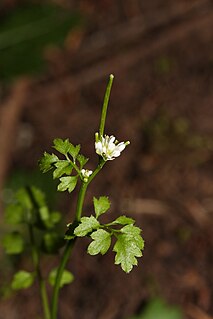
Matthiola is a genus of flowering plant in the mustard family Brassicaceae. It is named after Italian naturalist Pietro Andrea Mattioli (1501-1577). The genus contains about 50 species of annual, biennial and perennial herbaceous plants and subshrubs. Many are cultivated for their heavily scented, colorful flowers.

Cardamine is a large genus of flowering plants in the mustard family, Brassicaceae, known as bittercresses and toothworts. It contains more than 200 species of annuals and perennials. Species in this genus can be found worldwide, except the Antarctic, in diverse habitats. The name Cardamine is derived from the Greek kardaminē, water cress, from kardamon, pepper grass.

Isatis is a genus of flowering plants in the family Brassicaceae, native to the Mediterranean region east to central Asia. The genus includes woad. Due to their extremely variable morphology, the Asian species in particular are difficult to determine; the only reliable diagnostic feature is the ripe fruit. They are (usually) biennial or perennial herbaceous plants, often bluish and hairless or downy hairy with the upright stem branched.

Aethionema is a genus of flowering plants within the family Brassicaceae. They are known as stonecresses. Stonecresses originate from sunny limestone mountainsides in Europe and West Asia, especially Turkey.

Peltaria is a genus of flowering plants in the family Brassicaceae. Their distribution ranges from Southeast Europe, Near East to Central Asia. They prefer rocky slopes.
Ihsan Ali Al-Shehbaz, Ph.D. is an Iraqi American botanist who works as Adjunct Professor at University of Missouri-St. Louis and Senior Curator at Missouri Botanical Garden. Al-Shehbaz's primary area of interest is Brassicaceae and The Durango Herald called him "a world expert on taxonomy of the family". A 2008 publication of the United States Fish and Wildlife Service called him "the world's authority on species in the genus Lesquerella". The author abbreviation "Al-Shehbaz" is attached to the numerous botanical taxa he has identified.
Goldbachia is a genus of flowering plants belonging to the family Brassicaceae.

Aethionema grandiflorum, commonly known as Persian stonecress or Persian candytuft, is a flowering plant in the family Brassicaceae, preferring to grow at 750 to 2600 m on limestone slopes. It is sometimes kept as a garden plant, and occasionally naturalizes outside its original range of eastern Turkey, the southern Caucasus and northern Iran. It is a recipient of the RHS's Award of Garden Merit.
Weberbauera is a genus of flowering plants in the crucifer family Brassicaceae, native to the central Andes; Peru, Chile, Bolivia, and Argentina.
Sisymbriopsis is a genus of flowering plants in the crucifer family Brassicaceae, native to Central Asia and western China. They may have diversified due to mountain uplift.

Aubrieta libanotica, common name Lebanese rock cress, is a species of flowering plant in the mustard family Brassicaceae. The genus is named after Claude Aubriet, a French flower painter. A. Libanotica is native to the mountainous ranges of Lebanon and some parts of Syria.

Noccaea is a problematic genus of flowering plants in the family Brassicaceae, native to temperate areas of western North America, southern South America, northern Africa, Europe and Asia.

Ricotia is a genus of flowering plants in the family Brassicaceae, found in the Aegean islands, Crete, the Levant, the Sinai peninsula, Turkey, and the Transcaucasus. They appear to have arisen in Anatolia, to which five species are endemic.
Zuloagocardamum jujuyensis is a very rare, dwarf species of caudiciform cress-like plant in the family Brassicaceae which was first described in 2014. It is endemic to mountains in Jujuy Province in northern Argentina, where it is only known to grow on the grounds of El Aguilar mine at 3,700 meters in altitude. It is only known from a single recent collection. It is the only species in the new genus Zuloagocardamum, a monotypic genus. It is quite similar in fruit and flower to Chilocardamum and Weberbauera, but the taxonomists describing the species decided it was sufficiently distinguished by dint of its well-developed, woody caudex, and extremely reduced, leafless branches bearing small rosulate tufts of linear leaves, and sticky, mucilaginous seeds.
Chilocardamum is a small genus of four herbaceous cress-like species of plants in the family Brassicaceae, only found growing in Patagonia, southern Argentina.

Polypsecadium is a genus of large herbaceous species of plants in the family Brassicaceae, found growing in South America. Most of the species were formerly classified in the genus Sisymbrium.
Digitalis cariensis is a species of flowering plant in family Plantaginaceae. It is a type of foxglove. It is native from southwestern to southern Turkey.
Didymophysa is a genus of flowering plants belonging to the family Brassicaceae.
Pseudocamelina is a genus of flowering plants belonging to the family Brassicaceae.
Hedinia is a monotypic genus of flowering plants belonging to the family Brassicaceae. It only contains one known species, Hedinia tibetica.








